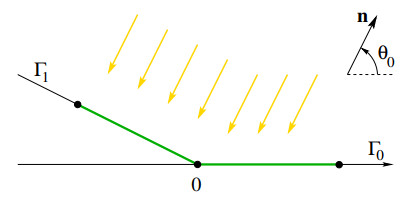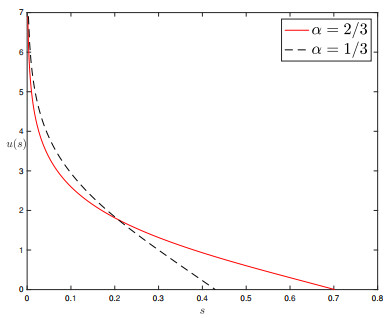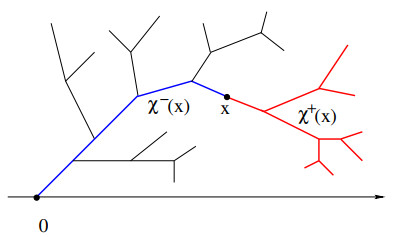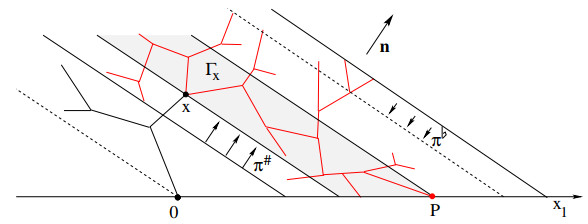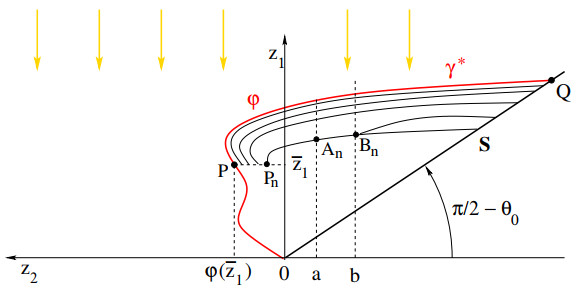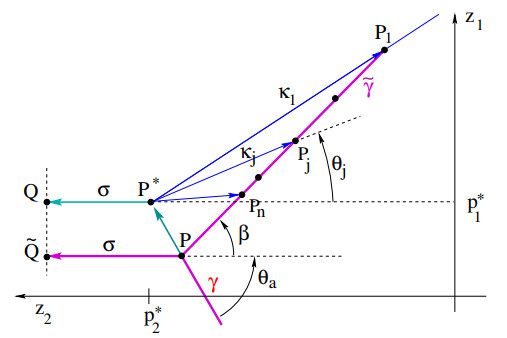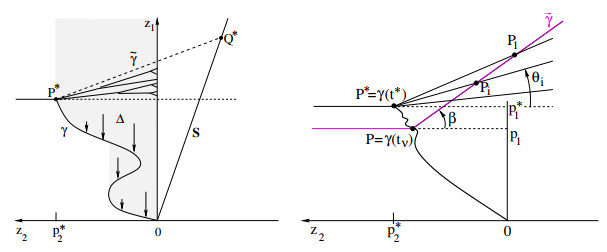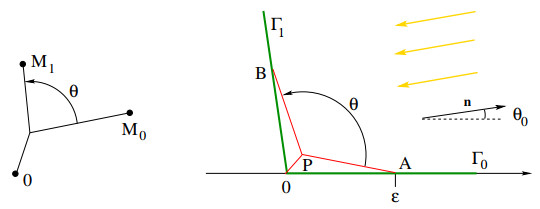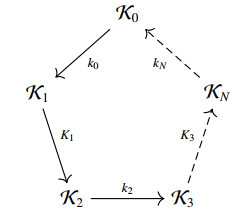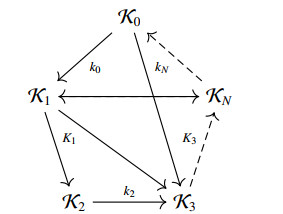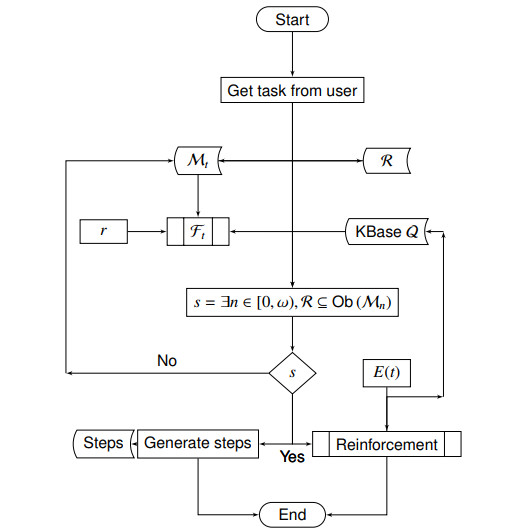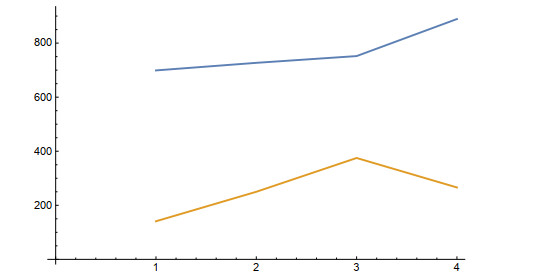1.
Introduction
In the recent papers [7,9] two functionals were introduced, measuring the amount of light collected by the leaves, and the amount of water and nutrients collected by the roots of a tree. In connection with a ramified transportation cost [1,14,18], these lead to various optimization problems for tree shapes.
Quite often, optimal solutions to problems involving a ramified transportation cost exhibit a fractal structure [2,3,4,12,15,16,17]. In the present note we analyze in more detail the optimization problem for tree branches proposed in [7], in the 2-dimensional case. In this simple setting, the unique solution can be explicitly determined. Instead of being fractal, its shape reminds of a solar panel.
The present analysis was partially motivated by the goal of understanding phototropism, i.e., the tendency of plant stems to bend toward the source of light. Our results indicate that this behavior cannot be explained purely in terms of maximizing the amount of light collected by the leaves (Fig. 1). Apparently, other factors must have played a role in the evolution of this trait, such as the competition among different plants. See [6] for some results in this direction.
The remainder of this paper is organized as follows. In Section 2 we review the two functionals defining the shape optimization problem and state the main results. Proofs are then worked out in Sections 3 to 5. Finally, in Section 6 we show the sharpness of the assumptions used in Theorem 2.5 and discuss various possible extensions.
2.
Statement of the main results
We begin by reviewing the two functionals considered in [7,9].
2.1. A sunlight functional
Let μ be a positive, bounded Radon measure on Rd+≐{(x1,x2,…,xd);xd≥0}. Thinking of μ as the density of leaves on a tree, we seek a functional S(μ) describing the total amount of sunlight absorbed by the leaves. Fix a unit vector
and assume that all light rays come parallel to n. Call E⊥n the (d−1)-dimensional subspace perpendicular to n and let πn:Rd↦E⊥n be the perpendicular projection. Each point x∈Rd can thus be expressed uniquely as
with y∈E⊥n and s∈R.
On the perpendicular subspace E⊥n consider the projected measure μn, defined by setting
Call Φn the density of the absolutely continuous part of μn w.r.t. the (d−1)-dimensional Lebesgue measure on E⊥n.
Definition 2.1. The total amount of sunlight from the direction n captured by a measure μ on Rd is defined as
More generally, given an integrable function η∈L1(Sd−1), the total sunlight absorbed by μ from all directions is defined as
In the formula (4), η(n) accounts for the intensity of light coming from the direction n.
Remark 1. According to the above definition, the amount of sunlight Sn(μ) captured by the measure μ only depends on its projection μn on the subspace perpendicular to n. In particular, if a second measure ˜μ is obtained from μ by shifting some of the mass in a direction parallel to n, then Sn(˜μ)=Sn(μ).
2.2. Optimal irrigation patterns
Consider a positive Radon measure μ on Rd with total mass M=μ(Rd), and let Θ=[0,M]. We think of ξ∈Θ as a Lagrangian variable, labeling a water particle.
Definition 2.2. A measurable map
is called an admissible irrigation plan for the measure μ if
(ⅰ) For every ξ∈Θ, the map t↦χ(ξ,t) is Lipschitz continuous. More precisely, for each ξ there exists a stopping time T(ξ) such that, calling
the partial derivative w.r.t. time, one has
(ⅱ) At time t=0 all particles are at the origin: χ(ξ,0)=0 for all ξ∈Θ.
(ⅲ) The push-forward of the Lebesgue measure on [0,M] through the map ξ↦χ(ξ,T(ξ)) coincides with the measure μ. In other words, for every open set A⊂Rd there holds
One may think of χ(ξ,t) as the position of the water particle ξ at time t.
To define the corresponding transportation cost, we first compute how many particles travel through a point x∈Rd. This is described by
We think of |x|χ as the total flux going through the point x. Following [13,14], we consider
Definition 2.3. For a given α∈[0,1], the total cost of the irrigation plan χ is
The α-irrigation cost of a measure μ is defined as
where the infimum is taken over all admissible irrigation plans for the measure μ.
Remark 2. Sometimes it is convenient to consider more general irrigation plans where, in place of (6), for a.e. t∈[0,T(ξ)] the speed satisfies |˙χ(ξ,t)|≤1. In this case, the cost (9) is replaced by
Of course, one can always re-parameterize each trajectory t↦χ(ξ,t) by arc-length, so that (6) holds. This does not affect the cost (11).
Remark 3. In the case α=1, the expression (9) reduces to
Of course, this length is minimal if every path χ(⋅,ξ) is a straight line, joining the origin with χ(ξ,T(ξ)). Hence
On the other hand, when α<1, moving along a path which is traveled by few other particles comes at a high cost. Indeed, in this case the factor |χ(ξ,t)|α−1χ becomes large. To reduce the total cost, it is thus convenient that many particles travel along the same path.
For the basic theory of ramified transport we refer to the monograph [1]. For future use, we recall that optimal irrigation plans satisfy
Single Path Property. If χ(ξ,τ)=χ(ξ′,τ′) for some ξ,ξ′∈Θ and 0<τ≤τ′, then
Another property that will be repeatedly used in the sequel is the following.
Lemma 2.4. Let χ be an admissible irrigation plan for the measure μ. Let C⊂Rd be a closed convex set containing the origin, and let pC:Rd↦C be the perpendicular projection. Consider the projected measure ˜μ supported on C, obtained as the push-forward of μ by the map pC. Then the composed map ˜χ(ξ,t)=pC(χ(ξ,t)) is an admissible irrigation plan for the measure ˜μ. Moreover, for every α∈[0,1] one has
If ˜μ≠μ, then the above inequality is strict.
Proof. The first statement is obvious. As in Lemma 5.15 in [1], the inequality (13) follows from the fact that, in the projected irrigation plan, the length of particle trajectories decreases while the multiplicity increases. Indeed,
2.3. The general optimization problem for branches
Combining the two functionals (4) and (10), one can formulate an optimization problem for the shape of branches:
(OPB) Given a light intensity function η∈L1(Sd−1) and two constants c>0, α∈[0,1], find a positive measure μ supported on Rd+ that maximizes the payoff
2.4. Optimal branches in dimension d=2
We consider here the optimization problem for branches in the planar case d=2. We assume that the sunlight comes from a single direction n=(cosθ0,sinθ0), so that the sunlight functional takes the form (3). Moreover, as irrigation cost we take (10), for some fixed α∈]0,1]. For a given constant c>0, this leads to the problem
over all positive measures μ supported on the half space R2+≐{x=(x1,x2);x2≥0}. To fix ideas, we shall assume that 0≤θ0≤π/2. Our main goal is to prove that for this problem the "solar panel" configuration shown in Fig. 2 is optimal, namely:
Theorem 2.5. In dimension d=2, assume that 0≤θ0≤π/2 and 1/2≤α≤1. Then the optimization problem (15) has a unique solution. The optimal measure is supported along two rays, namely
When 0<α<1/2, the same conclusion holds if either θ0=0, or else the angle θ0 satisfies
In the case α=1 the result is straightforward. Indeed, for any measure μ we can consider its projection ˜μ on Γ0∪Γ1, obtained by shifting the mass in the direction parallel to the vector n. In other words, for x∈R2 call ϕn(x) the unique point in Γ0∪Γ1 such that ϕn(x)−x is parallel to n. Then let ˜μ be the push-forward of the measure μ w.r.t. ϕn. Since this projection satisfies |ϕn(x)|≤|x| for every x∈R2+, the transportation cost decreases. On the other hand, by Remark 1 the sunlight captured remains the same. We conclude that
with strict inequality if μ is not supported on Γ0∪Γ1.
In the case 0<α<1, the result is not so obvious. A proof of Theorem 2.5 will be worked out in Sections 3 and 4.
Having proved that the optimal measure μ is supported on the two rays Γ0∪Γ1, the density of μ w.r.t. one-dimensional measure can then be determined using the necessary conditions derived in [6]. Indeed, the density u0 of μ along the ray Γ0 provides a solution to the scalar optimization problem
among all non-negative functions u:R+↦R+. Here s is the arc-length variable along Γ0.
We write (18) in the form
subject to
The necessary conditions for optimality (see for example [8,11]) now yield
where the dual variable q satisfies
Notice that, by (21), u>0 only if q<1. Combining (20) with (22) one obtains an ODE for the function q↦z(q), with q∈[0,1]. Namely
This equation admits the explicit solution
Inserting (24) in (22), we obtain an implicit equation for q(s):
In turn, the density u(s) of the optimal measure μ along Γ0, as a function of the arc-length s, is recovered from (21). Notice that this measure is supported only on an initial interval [0,ℓ0], determined by
In particular, the total mass M0 along the ray Γ0 is computed setting q=0 in (24), namely
The density of the optimal measure along the ray Γ1 is computed in an entirely similar way. In fact, it corresponds to the special case of setting θ0=π/2 in the previous computations. Along Γ1, the optimal measure μ is supported on an initial interval [0,ℓ1], where
while the total mass is given by
An illustration of how the corresponding density profile u(s) looks like for different values of α is displayed in Fig. 3.
2.5. The case α=0
In the analysis of the optimization problem (OPB), the case α=0 stands apart. Indeed, the general theorem on the existence of an optimal shape proved in [7] does not cover this case.
When α=0, a measure μ is irrigable only if it is concentrated on a set of dimension ≤1. When this happens, in any dimension d≥3 we have Sη(μ)=0 and the optimization problem is trivial. The only case of interest occurs in dimension d=2. In the following, ⟨⋅,⋅⟩ denotes the inner product in R2.
Theorem 2.6. Let α=0, d=2. Let η∈L1(S1) and define
(i) If K>c, then the optimization problem (OPB) has no solution, because the supremum of all possible payoffs is +∞.
(ii) If K≤c, then the maximum payoff is zero, which is trivially achieved by the zero measure.
A proof will be given in Section 5.
3.
Properties of optimal branch configurations
In this section we consider the optimization problem (15) in dimension d=2. As a step toward the proof of Theorem 2.5, some properties of optimal branch configurations will be derived.
By the result in [7] we know that an optimal measure μ exists and has bounded support, contained in R2+≐{(x1,x2);x2≥0}. Call M=μ(R2+) the total mass of μ and let χ:[0,M]×R+↦R2+ be an optimal irrigation plan for μ.
Next, consider the set of all branches, namely
By the single path property, we can introduce a partial ordering among points in B. Namely, for any x,y∈B we say that x⪯y if for any ξ∈[0,M] we have the implication
This means that all particles that reach the point y pass through x before getting to y.
For a given x∈B the subsets of points y∈B that precede or follow x are defined as
respectively (see Fig. 4).
We begin by deriving some properties of the sets χ+(x). Introducing the unit vectors e1=(1,0), e2=(0,1), we denote by Re1 the set of points on the x1-axis. As before, n=(cosθ0,sinθ0) denotes the unit vector in the direction of the sunlight. Throughout the following, the closure of a set A is denoted by ˉA, while ⟨⋅,⋅⟩ denotes an inner product.
Lemma 3.1. Let the measure μ provide an optimal solution to the problem (15), and let χ be an optimal irrigation plan for μ. Then, for every x∈B, one has
where ax≐⟨n,x⟩, while bx is defined as follows.
● If ¯χ+(x)∩Re1=∅, then bx=ax=⟨n,x⟩.
● If ¯χ+(x)∩Re1≠∅, then
Proof. The right-hand side of (32) is illustrated in Fig. 5. To prove the lemma, consider the set of all particles that pass through x, namely
1. We first show that, by the optimality of the solution,
Indeed, consider the perpendicular projection on the half plane
Define the projected irrigation plan
Then the new measure μ♯ irrigated by χ♯ is still supported on R2+ and has exactly the same projection on E⊥n as μ. Hence it gathers the same amount of sunlight. However, if the two irrigation plans do not coincide a.e., then the cost of χ♯ is strictly smaller than the cost of χ, contradicting the optimality assumption.
2. Next, we show that
Indeed, call
If b″≤bx, we are done. In the opposite case, by a continuity and compactness argument we can find δ>0 such that the following holds. Introducing the perpendicular projection on the half plane
one has
Similarly as before, define the projected irrigation plan
Then the new measure μ♭ irrigated by χ♭ is supported on R2+∩S♭ and has exactly the same projection on E⊥n as μ. Hence it gathers the same amount of sunlight. However, if the two irrigation plans do not coincide a.e., then the cost of χ♭ is strictly smaller than the cost of χ, contradicting the optimality assumption. This completes the proof of the Lemma.
Based on the previous lemma, we now consider the set
It will be convenient to rotate coordinates by an angle of π/2−θ0, and choose new coordinates (z1,z2) oriented as in Fig. 6. In these new coordinates, the direction of sunlight becomes vertical, while the positive x1-axis corresponds to the line
Calling (z1(ξ,t),z2(ξ,t)) the corresponding coordinates of the point χ(ξ,t), from Lemma 3.1 we immediately obtain
Lemma 3.2. Let χ be an optimal irrigation plan for a solution to (15). Then
(i) For every ξ∈[0,M], the map t↦z1(ξ,t) is non-decreasing.
(ii) If ˉz=(ˉz1,ˉz2)∉B∗, then χ+(ˉz) is contained in a horizontal line. Namely,
To make further progress, we define
Moreover, on the interval [0,zmax1[ we consider the function
Lemma 3.3. For every z1∈[0,zmax1[, the supremum φ(z1) is attained as a maximum.
Proof. 1. Assume that, on the contrary, for some ˉz1 the supremum is not a maximum. In this case, as shown in Fig. 7, there exist a sequence of points Pn→P with Pn=(ˉz1,sn), P=(ˉz1,ˉz2), sn↑ˉz2. Here Pn∈B∗ for every n≥1 but P∉B∗. Without loss of generality, we can assume that all points Pn lie on distinct branches (i.e., there is no couple m≠n such that Pm⪯Pn or Pn⪯Pm). Otherwise, we could group all these points into finitely many horizontal branches. But since every horizontal branch intersects the horizontal line through P in a closed interval, this would already imply that the supremum in (39) is attained.
2. Choose two values a,b such that
By construction, for every n≥1 the set ¯χ+(Pn) intersects S. Therefore we can find points
all in B∗, with
3. Since the total mass M is finite, we have
We can thus find N large enough so that the amount of particles εN≐|AN|χ going through AN is so small that
Consider the modified transport plan ˜χ, obtained from χ by removing all particles that go through the point BN. More precisely, ˜χ is the restriction of χ to the domain
Let ˜μ be the measure irrigated by ˜χ.
Calling σ0>0 the total amount of particles going through BN, since ˜μ≤μ, the total amount of sunlight gathered by the measure ˜μ satisfies
We now estimate the reduction in the transportation cost, achieved by replacing μ with ˜μ. Let γ:[sA,sB]↦R2 be an arclength parameterization of the branch from AN to BN. Along this arc, when all the particles reaching BN are removed, the multiplicity (8) decreases from |γ(s)|χ to |γ(s)|χ−σ0. The transportation cost through γ is reduced in the amount
This yields
If (40) holds, combining (41)-(42) one obtains
Hence the measure μ is not optimal. This contradiction proves the lemma.
By the previous result, the graph of φ is contained in one single maximal trajectory of the transport plan χ. As in Figure 8, we denote this curve by γ, which provides the left boundary of the set B∗.
Along the curve γ, we now consider the set of points Cj=(z1,j,z2,j) where some horizontal branch bifurcates on the left. A property of such points is given below.
Lemma 3.4. In the above setting, for every j, one has
Proof. If (43) fails, there exists another point C∗j=(z∗1,j,z2,j) along the curve γ, with z∗1,j<z1,j. We can now replace the measure μ by another measure ˜μ obtained as follows. All the mass lying on the horizontal half-line {(z1,j,s);s≥z2,j} is shifted downward on the half-line {(z∗1,j,s);s≥z2,j}. Since the functional Sn is invariant under vertical shifts, we have Sn(˜μ)=Sn(μ). However, the transportation cost is strictly smaller: Iα(˜μ)<Iα(μ). This contradicts the optimality of μ.
Next, as shown in Fig. 8, we consider a point P∗=(p∗1,p∗2)∈γ where the component z2 achieves its maximum, namely
Notice that such a maximum exists because γ is a continuous curve, starting at the origin. If this maximum is attained at more than one point, we choose the one with smallest z1-coordinate, so that
Moreover, call
and let Q∗=(q∗1,q∗2)∈S be the point on the ray S whose second coordinate is q∗2. Recalling the notation of Lemma 3.1, we note that q∗1=bx for x=(0,0). We claim that, by the optimality of the solution, all paths of the irrigation plan χ must lie within the convex set
Otherwise, call π∗:R2↦Σ∗ the perpendicular projection on the convex set Σ∗, and let μ∗ be the push-forward of μ by the map π∗. By Lemma 2.4 the composed map
is an irrigation plan for μ∗ and satisfies Eα(χ∗)<Eα(χ). Hence
contradicting the optimality assumption.
By a projection argument we now show that, in an optimal solution, all the particle paths remain below the segment γ∗ with endpoints P∗ and Q∗.
Lemma 3.5. In the above setting, let
be the segment with endpoints P∗,Q∗. If
is an optimal irrigation plan for the problem (15), then for a.e. ξ∈Θ we have the implication
Proof. 1. It suffices to show that the maximal curve γ lies below γ∗. If this is not the case, consider the set of particles which go through the point P∗ and then move to the right of P∗, namely
Notice that, by the single path property (see Section 7.1 in [1]), all these particles follow the same path from the origin to P∗. Hence the length t∗ of this path is the same for all ξ∈Ω∗.
2. Consider the convex region below γ∗, defined by
Let π:R2↦Σ be the perpendicular projection. Then the irrigation plan
has total cost strictly smaller than χ. Indeed, for all x and a.e. ξ,t we have
Notice that, in (50), equality can hold for a.e. ξ,t only in the case where χ=χ†.
3. We now observe that the perpendicular projection on Σ can decrease the z2-component. As a consequence, the measures μ and μ† irrigated by χ and χ† may have a different projections on the z2 axis. If this happens, we may have Sn(μ)≠Sn(μ†).
To address this issue, we observe that all particles ξ∈Ω∗ satisfy χ†(ξ,t∗)=χ(ξ,t∗)=P∗. In terms of the z1,z2 coordinates, this implies
By continuity, for each ξ∈Ω∗ we can find a stopping time τ(ξ)∈[t∗,T(ξ)] such that
Call ˜χ the truncated irrigation plan, such that
By construction, the measures μ and ˜μ irrigated by χ and ˜χ have exactly the same projections on the z2-axis. Hence Sn(˜μ)=Sn(μ). On the other hand, the corresponding costs satisfy
This contradicts optimality, thus proving the lemma.
4.
Proof of Theorem 2.5
In this section we give a proof of Theorem 2.5. We recall that the functional (15) to be maximized is the difference between a payoff, i.e. the sunlight Sn(μ) absorbed by the measure μ, and the ramified transportation cost cIα(μ). Together with the measure μ, at various steps of the proof we shall construct a second measure ˜μ, obtained by shifting part of the mass in a direction parallel to n. As in Remark 1, this will not change the sunlight gathered: Sn(˜μ)=Sn(μ). On the other hand, the irrigation cost of ˜μ is strictly smaller: Iα(˜μ)<Iα(μ). We shall conclude that μ is not optimal.
As shown in Fig. 8, let P∗=(p∗1,p∗2) be the point defined at (44). We consider two cases:
(ⅰ) P∗=0∈R2,
(ⅱ) P∗≠0.
Assume that case (ⅰ) occurs. Then, by Lemma 3.4, the only branch that can bifurcate to the left of γ must lie on the z2-axis. Moreover, by Lemma 3.5, the path γ cannot lie above the segment with endpoints P∗, Q∗. Therefore, the restriction of the measure μ to the half space {z2≤0} is supported on the line S. Combining these two facts we achieve the conclusion of the theorem.
The remainder of the proof will be devoted to showing that the case (ⅱ) cannot occur, because it would contradict the optimality of the solution.
To illustrate the heart of the matter, we first consider the elementary configuration shown in Fig. 9, left, where all trajectories are straight lines. Water is first transported from the origin to the point P∗. Then, an amount σ>0 is moved horizontally to the point Q, while an amount κ>0 is moved to P1. This yields a transport plan χ, which irrigates the measure μ consisting of a mass σ at Q and a mass κ at P1.
Next, as shown in Fig. 9, right, we consider a point P along the segment 0P∗. A new transport plan ˜χ is defined, where water is first transported from the origin to P. Then, an amount σ is moved horizontally to a point ˜Q located along the same vertical line as Q. The remaining amount κ is moved in a straight line from P to P1. Notice that the new transport plan ˜χ now irrigates a measure ˜μ consisting of a mass σ at ˜Q and a mass κ at P1.
To fix ideas, we denote the lengths of the segments PP∗ and P∗P1 as
The angles between these segments and a horizontal line will be denoted by θa,θb, respectively. The next lemma provides a comparison between the costs of the two irrigation plans χ and ˜χ.
Lemma 4.1. Let σ≥0, κ>0 be given, together with angles θa∈[0,π/2] and θb∈[0,π/2[. Let χ,˜χ be the irrigation plans defined above, as shown in Fig. 9. If 0<α<1/2 and θb satisfies the additional bound
or if α≥1/2, then there exists ε>0 such that ℓa/ℓb≤ε implies
Proof. 1. To compute the difference between the quantities in (55), notice that the old transportation cost along PP∗ and P∗P1,
is replaced by the new cost
Notice that the last term in (56) accounts for the fact that an amount σ of particles need to cover a longer horizontal distance, traveling along the segment P˜Q instead of P∗Q.
The difference in the cost is thus expressed by the function
2. Introducing the variables
we obtain
Setting
we are thus led to study the function
and to find conditions which imply the positivity of F.
3. The function F in (58) can be written in terms of an inner product:
To prove that F>0 it thus suffices to show that the second vector on the right hand side of (59) has length smaller than one, namely
This inequality holds provided that
Two cases must be considered. If α≥1/2, then
Hence (60) trivially holds for all θb<π/2.
On the other hand, if α<1/2, consider the function
We observe that, for 0≤α≤12, one has
while
From (61) it now follows that the condition (54) guarantees that (60) holds, hence F≥0, as required.
Summarizing the previous analysis, for any λ∈]0,1[ and θa∈[0,π/2], we have proved:
(ⅰ) When α≥1/2, one has F(λ,θa,θb)>0 for all θb∈[0,π/2[.
(ⅱ) When 0<α<1/2 one has F(λ,θa,θb)>0 provided that θb satisfies the additional bound (54).
4. Combining (57) with (58), we obtain
By the previous step, in both cases (ⅰ) and (ⅱ) the right hand side of (62) is strictly positive provided that the ratio ℓa/ℓb is sufficiently small. This yields (55).
We now consider a more general irrigation plan χ, shown in Fig. 10. Water is transported from the origin along a straight path γ, up to the point P∗. Then the flux is split into a finite number of straight paths. One goes horizontally to the left, with flux σ≥0, reaching a point Q. The other paths go to the right, with fluxes κ1,…,κn>0, at angles
until they reach points P1,…,Pn. This provides an irrigation plan for the measure concentrating a mass σ at the point Q and masses κ1,…,κn at the points P1,…,Pn. As shown in Fig. 10, we assume that all points Pi lie on the same straight line ˜γ, which intersects γ at a point P.
We compare this configuration with a modified irrigation plan ˜χ defined as follows. First, the plan ˜χ moves all the mass from the origin along the straight line γ up to the point P. Then an amount of mass σ is moved horizontally to the left, until it reaches a point ˜Q on the same vertical line as Q. The remaining mass κ=κ1+⋯+κn is moved along the segment ˜γ, until it reaches the various points P1,…,Pn. Notice that ˜χ is an irrigation plan for a measure ˜μ which concentrates a mass σ at the point ˜Q and masses κ1,…,κn at the points P1,…,Pn. As shown in Fig. 10, we call θa∈[0,π/2] the angle between γ and a horizontal line, and let β∈[0,π/2[ be the angle between ˜γ and a horizontal line.
Lemma 4.2. Let the masses σ≥0 and κ1,…,κn>0 be given, together with angles θa∈[0,π/2] and θi∈[0,π/2[ as in (63). Let χ,˜χ be the irrigation plans defined above, as shown in Fig. 10. If 0<α<1/2 and θ1 satisfies the additional bound
or if α≥1/2, then there exists ε>0 such that 0<β−θ1<ε implies
Proof. 1. The left-hand side of (65), describing the difference between the old and the new transportation cost, can be expressed as
where, for notational convenience, we set Pn+1≐P. According to (66) we can write
where
2. Notice that the quantity A in (68) would describe the difference in the costs if all the mass κ=κ1+⋯+κn were flowing through the point P1. We claim that
Indeed, the last two terms within the square brackets in (70) are derived from
Using Lemma 4.1, we can now choose ε′>0 small enough such that, if
then the right hand side of (70) is strictly positive. It now suffices to observe that, given all the angles θa,θ1,…,θn, by choosing ε>0 small enough one achieves the implication
In turn, this implies the strict inequality
3. To complete the proof of the lemma, it remains to prove that Sn≥0. This will be proved by induction on n. Starting from (69) and using the inequalities
we obtain
where in the second equality we have used |Pn−1−P1|=|Pn−P1|−|Pn−Pn−1|. Repeating this same argument, by induction we obtain
Observing that
the proof of the lemma is completed.
Remark 4. As soon as all the masses σ,κ1,…,κn and all the angles θa,β,θ1,…,θn have been assigned, the difference between the two irrigation costs in (65) is a positive homogeneous function of the distance |P1−P∗|. We can thus replace (65) with the inequality
for some c0>0 depending on all the above constants. Notice that, by continuity, the bound (75) remains valid if θa is replaced by some other angle θ′a, with |θ′a−θa| sufficiently small.
4.1. Completion of the proof
Let μ be an optimal measure, maximizing the functional (15), and let χ:Θ×R+↦R2 be an optimal irrigation plan for μ. According to (6), we assume that all paths are parameterized by arc-length.
As remarked at the beginning of this section, a proof of Theorem 2.5 can be achieved by showing that, for an optimal solution, the point P∗=(p∗1,p∗2) introduced at (44) must coincide with the origin. We recall that by definition we must necessarily have p∗2≥0 since the maximal curve γ contains the origin. Moreover, p∗2=0 implies p∗1=0, since by a projection argument, this leads to a lower irrigation cost. Throughout the following we shall thus assume p∗2>0 and derive a contradiction.
1. Call
the set of particles that move through P∗. Notice that, by the single path property, there exists a unique path γ:[0,t∗]↦R2 such that
As a consequence, in (76) the time t∗ is the same for all ξ∈Θ∗.
Within the set Θ∗ of all particles reaching P∗, we distinguish the ones which proceed to the left or to the right of P∗, namely
Here Θl denotes the set of particles that, after reaching P∗, move along the horizontal line {(z1,z2);z1=p∗1,z2>p∗2} to the left of P∗. Moreover, Θr=Θ∗∖Θl is the set of particles which, after reaching P∗, move to the right. For all ξ∈Θr and t>t∗, we thus have
For future use, we denote
2. In connection with the path γ at (77), consider the set (the shaded region in Fig. 11)
We claim that the measure μ cannot concentrate any mass on the open set Δ. Indeed, if μ(Δ)>0, then we consider the measure ˆμ obtained by vertically shifting all the mass in Δ until it touches some point on the curve Γ. More precisely, let ϕ:Δ↦{γ(t);t∈[0,t∗]} be a measurable map such that ϕ(z1,z2)=(ˆz1,z2), with ˆz1 as in (81). Furthermore, outside the set Δ we extend the map by the identity, that is, ϕ(z1,z2)=(z1,z2). Let ˆμ be the push-forward of the measure μ by the map ϕ. This new measure μ would then satisfy
contradicting the optimality of μ.
3. The previous argument shows that there are no sinks inside Δ. Hence all particles ξ∈Θr continue to move to the right of P∗, eventually crossing the z1-axis. For ξ∈Θr we can thus define the stopping time
and introduce the measure ˉμ, supported on the z1-axis, defined by
We observe that the restriction of χ to the set
yields an optimal transport plan from a point mass located at P∗ to the measure ˉμ.
By the interior regularity property (see Theorem 8.16 in [1], or Theorem 4.10 in [19]), outside a neighborhood of the support of ˉμ, the optimal transport plan is supported on a finite union of line segments. In particular, restricted to the set {z2>p∗2/2}, all paths χ(ξ,⋅), with ξ∈Θr, t>t∗ are contained within finitely many line segments.
4. By the previous step, within a neighborhood of P∗, all particle paths which move out of P∗ are contained in finitely many straight lines starting at P∗.
Adopting the same notation used in Lemma 4.2, we call σ=meas(Θl) the amount of mass which moves horizontally to the left of P∗. As in (63), we call θ1,…,θn the angles formed by the line segments to the right of P∗ with a horizontal line (see Fig. 11, right). The fluxes along these line segments are denoted by κ1,…,κn. We introduce the decomposition
where Θi denotes the set of particles ξ∈Θr that move along the i-th segment. Notice that, with this notation, one has κi=meas(Θi).
We recall that, by Lemma 3.5, all particle paths χ(ξ,t), ξ∈Θr, lie below the segment γ∗ with endpoints P∗, Q∗. This implies that all angles θ1,…,θn are strictly smaller than π2−θ0. By the assumption (17), we are led to consider two cases.
Case 1: 1/2≤α≤1 and 0≤θ1<π/2,
Case 2: 0<α<1/2 and
5. In this step, under the assumption that p∗2>0, we construct a competing measure ˜μ. Using Lemma 4.2, this will eventually allow us to conclude that the measure μ is not optimal.
For t<t∗, consider the unit vector
By compactness, there exists an increasing sequence tν→t∗− such that
for some unit vector ˉw=(ˉw1,ˉw2), with ˉw1≤0, ˉw2≤0. Call θa∈[0,π/2] the angle between ˉw and a horizontal line.
In connection with the masses σ,κ1,…,κn and the angles θ1,…,θn defined above, we now choose an angle β>θ1, sufficiently close to θ1, so that the conclusion of Lemma 4.2 holds. In particular, by Remark 4 the inequality (75) holds.
Next, we choose ν≥1 sufficiently large (its precise value will be determined later), and consider the point P=(p1,p2)=γ(tν). Again referring to Fig. 11, right, we denote by ˜γ the straight line through P, forming an angle β with a horizontal line. As in Lemma 4.2, we denote by P1,…,Pn the points where ˜γ intersects the line segments through P∗, forming angles 0≤θn<⋯<θ1 with a horizontal line.
A new measure ˜μ and a new irrigation plan ˜χ are now defined as follows.
● The measure ˜μ is obtained from μ by vertically shifting all the mass located on the horizontal line to the left of P∗ downward on the horizontal line to the left of P. More precisely, ˜μ is the push-forward of μ by the map
● Recalling (78), for ξ∉Θ∗ we simply set ˜χ(ξ,t)=χ(ξ,t) for all t≥0.
● Particles ξ∈Θl move along the path γ up to the point P. Then the move horizontally to the left of P, stopping at a point ˜χ(ξ,˜T(ξ)) on the same vertical line as χ(ξ,T(ξ)).
● Particles ξ∈Θr move along the path γ up to the point P. Then they move along ˜γ until they reach the corresponding points P1,…,Pn. Afterwards, the remaining portions of their trajectories are exactly as before.
6. By construction we have Sn(˜μ)=Sn(μ). To analyze the cost of the new irrigation plan ˜χ, consider the set
This is the set of particles that go through P, but do not reach P∗ afterwards: either they stop along γ, or they move to some other branch bifurcating from γ before reaching P∗.
We observe that, in the case where Θ†ν=∅, one can immediately apply Lemma 4.2 and conclude
The following analysis will show that the same conclusion can still be reached, provided that P is sufficiently close to P∗ and
is sufficiently small. For future use, we observe that
We are now ready to estimate the difference between the two irrigation costs, in the general case.
(1) For ξ∉Θ∗∪Θ†ν, we have
for all t>0. Hence these particles do not contribute to the difference in the transportation cost.
(2) For ξ∈Θ†ν, the first identity in (88) still holds for all t>0. However, the second one holds only for t∉[tν,τ(ξ)], where
is the time when the particle ξ either stops, or leaves the path γ. We estimate the difference
(3) It remains to estimate the difference in the cost for transporting particles ξ∈Θ∗, namely
The estimate of B is based on the following observation. If the portion of the curve γ between P and P∗ were a straight segment, and if on this segment the multiplicity were constantly equal to σ+κ, then we could use Lemma 4.2 and Remark 4. By (75) we could thus conclude
In the general case, recalling (86), the multiplicity along γ is estimated by
The presence of the additional particles ξ∈Θ†ν increases the multiplicity and hence reduces the cost of χ. The amount by which this cost is reduced can be bounded above by
On the other hand, the fact that the curve γ is not necessarily a straight line increases the cost of χ in an amount which is bounded below by
Combining all the previous observations, from (89), (91), (92), and (93), we conclude
We claim that, for some choice of ν≥1 large enough, the right hand side of (94) becomes negative, thus contradicting the optimality of the measure μ. We consider two cases.
Case 1: (t∗−tν)≤2|γ(tν)−P∗| for infinitely many integers ν≥1. When this inequality holds, (94) yields
We now observe that the limit (84) implies an inequality of the form
for a suitable constant C and all ν sufficiently large. Therefore, as δν→0, it is clear that the right hand side of (95) becomes negative. This contradicts the optimality of μ.
Case 2: (t∗−tν)≥2|γ(tν)−P∗| for infinitely many integers ν≥1. When this inequality holds, (94) yields
When δν is sufficiently small, the right hand side of (96) becomes negative. Once again, this contradicts the optimality of μ.
5.
The case d=2, α=0
We give here a proof of Theorem 2.6.
1. Assume that there exists a unit vector w∗∈R2 such that
Let v=(cosβ,sinβ) be a unit vector perpendicular to w∗, with β∈[0,π]. Let μ be the measure supported on the segment {rv;r∈[0,ℓ]}, with constant density λ w.r.t. 1-dimensional Lebesgue measure.
Then the payoff achieved by μ is estimated by
By choosing λ>0 large enough, the first factor on the right hand side of (97) is strictly positive. Hence, by increasing the length ℓ, we can render the payoff arbitrarily large.
2. Next, assume that K≤c. Consider any Lipschitz curve s↦γ(s), parameterized by arc-length s∈[0,ℓ]. Then, for any measure μ supported on γ, the total amount of sunlight from the direction n captured by μ satisfies the estimate
Indeed, it is bounded by the length of the projection of γ on the line E⊥n perpendicular to n. Integrating over the various sunlight directions, one obtains
More generally, μ=∑iμi can be the sum of countably many measures supported on Lipschitz curves γi. In this case, since the sunlight functional is sub-additive, one has
Hence
This concludes the proof of case (ⅱ) in Theorem 2.6.
6.
Concluding remarks
We first clarify the role of the assumption (17), used in Theorem 2.5 when 0<α<1/2.
Consider the problem of irrigating two masses M0,M1>0 from the origin. Then, as shown in Fig. 12, left, the optimal bifurcation angle satisfies
For a proof, see Lemma 12.2 of [1]. As a consequence, we have the implications
Notice that cosθ=22α−1−1 when M0=M1 and hence λ=1/2. As a consequence, regardless of the relative sizes of M0,M1, we have:
● When α≥1/2, a bifurcation with an angle θ>π/2 cannot be optimal.
● When α<1/2, a bifurcation with an angle θ such that cosθ<22α−1−1 cannot be optimal.
This is the underlying motivation for the assumption (17), repeatedly used in the proofs. Notice that a similar assumption (54) was introduced in Lemma 4.1.
It is interesting to speculate whether the conclusion of Theorem 2.5 may still hold when α<1/2 while the angle θ0>0 is arbitrarily small. Consider any measure μ supported on the two half-lines Γ0∪Γ1 as shown in Fig. 12, right. The necessary conditions derived for the problem (18) allow us to compute the total mass concentrated by the measure μ on each of these half-lines. Indeed, according to (26) and (27), we have
Therefore
In order for this configuration to be optimal, a necessary condition is
Indeed, if (101) fails, a better configuration could be constructed as shown in Fig. 12, right. Here A and B are points along Γ0 and Γ1 respectively, at distance ε>0 from the origin, while P is a suitable point such that the angle between PA and PB equals θ. To uniquely determine P, we again refer to the necessary conditions in Lemma 12.2 of [1]. Replacing the segments 0A and 0B with the three segments 0P, PA, and PB, we can obtain a new configuration where the transportation cost is reduced by O(1)⋅ε, while keeping the same value of the sunlight functional. Therefore, our initial configuration where the measure μ is supported on Γ0∪Γ1 would not be optimal.
The inequality (101) is precisely what is needed to rule out this possibility. Namely, if (101) holds, then the point P cannot lie inside the sector bounded by Γ0 and Γ1. Recalling (100), we can write (101) in the form
Equivalently:
We observe that ϕ(0)=0 while ϕ(1)=−2. In addition,
for 0<λ<1. This implies that ϕ(λ)<0 for 0<λ<1. Therefore, the necessary conditions for optimality (101) are always satisfied, even when the angle θ0 is very small.
We conclude this paper by discussing possible extensions of our results.
(I) Motivated by the previous analysis, we conjecture that the conclusion of Theorem 2.5 remains valid even without the assumption (17). Namely, for all 0<α<1/2 and every θ0∈[0,π/2], the optimal measure μ is still supported on the union of the two rays Γ0∪Γ1. To achieve a proof, however, an additional argument will be needed. More specifically, the assumption (54) in Lemma 4.1 can be removed only by imposing some additional restriction on the value of λ=σκ+σ∈[0,1]. Our construction in Section 4, however, does not yield such information.
(II) In Theorem 2.5 it was assumed that sunlight comes from one single direction. In the case considered at (4), where sunlight comes with varying intensity from different directions, one may conjecture that a similar result still holds true. This guess seems very reasonable if the support of the function η∈L1(S1) is contained within a small sector, say [θ0−δ,θ0+δ]. We remark, however, that proving such a result will require a substantially different approach. In the proof of Theorem 2.5, we repeatedly used the fact (highlighted in Remark 1) that, shifting part of the mass of μ along the direction n of sunlight, one obtains a new measure ˜μ which collects exactly the same amount of sunlight: Sn(˜μ)=Sn(μ). This crucial property fails as soon as we replace Sn with Sη, allowing sunlight to come from different directions.
(III) It would be interesting to analyze the optimal branch configuration in three space dimensions. To fix ideas, assume that sunlight comes from the direction parallel to n=(cosθ0,0,sinθ0), and call e=(0,0,1) the unit vector in the vertical direction. Then it is easy to see that the optimal measure μ must be supported within the convex closure of the two half-planes
In addition, the Hausdorff measure of Supp(μ) must be ≥2. Otherwise, the collected sunlight would be Sn(μ)=0. A challenging question is whether the support of μ is indeed contained in a two-dimensional surface. In this case, the optimal irrigation plan should have a structure similar to the one studied in [16].
Acknowledgments
The research of the first author was partially supported by NSF with grant DMS-1714237, "Models of controlled biological growth". The research of the second author was partially supported by a grant from the U.S.-Norway Fulbright Foundation.
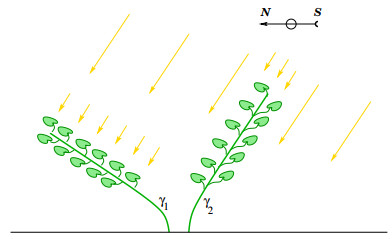









 DownLoad:
DownLoad:
